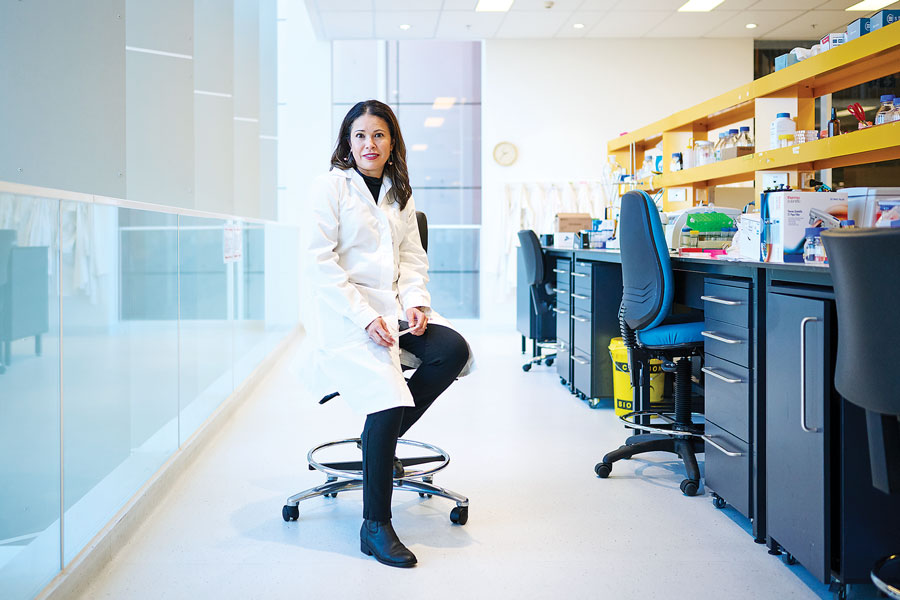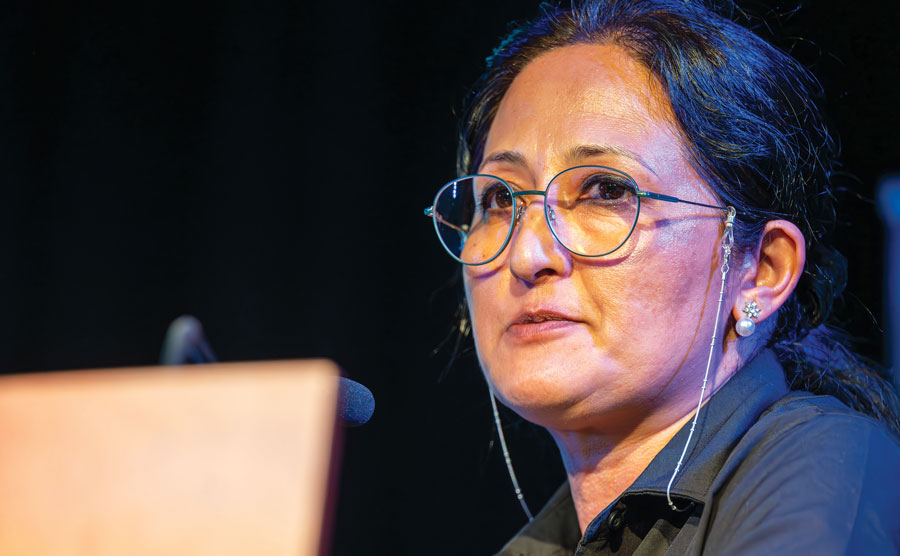Australia
July 26, 2024
.jpg)
The long-running GRDC-supported rust program is led by CSIRO and the University of Sydney. - Photo: Rohan Thomson
The fifth phase of the Australian Cereal Rust Control Program comprises projects that are exploring ways to find the highest-value rust resistance genetics and optimise their function.
CSIRO Pests and Diseases group leader Professor Melania Figueroa says this phase will allow for all the work on identifying valuable resistance genes to be brought to growers.
The long-running GRDC-supported program is led by CSIRO and the University of Sydney. Over many years it has advanced technologies and applications to best utilise known resistance sources, discover new sources and improve the cataloguing of rust resistance genes.
CSIRO projects
Professor Figueroa says the program is finding a balance between meeting immediate needs and providing capacity for new technology.
Machine learning toolkit
A CSIRO and University of Queensland collaboration, led by project leader Dr Peter Dodds, is developing machine-learning algorithms to find the most-effective combinations of rust resistance genetics.
Using genetic variations present in diverse wheat germplasm collated through previous projects, a computational system will be used to identify the best genetic combinations and then the most-efficient method of crossing to achieve optimal rust resistance.
The University of Queensland’s Professor Lee Hickey says the first challenge is to work out which chromosome blocks are desirable for breeding a rust-resistant variety. Part of what makes this challenging is trying to account for multiple diseases, with a particular focus on leaf rust and stripe rust.
“When you’re trying to combine two or three genes, it’s quite a straightforward breeding exercise. But when you start to try to combine 10 or more genes, it becomes a much greater challenge,” Professor Hickey says.
To make the numbers less overwhelming, CSIRO has partnered with the University of Queensland to build a number-crunching toolkit.
The toolkit uses artificial intelligence in the form of a genetic algorithm. It can search through the available wheat plant accessions and identify the best parents to use in crossing to maximise the blocks across the genome for rust resistance.
The final step will be to put the simulations into practice and complete the crosses suggested by the models to generate a variety as a proof of concept.
From this project, there are two main deliverables for Australian wheat breeders, Professor Hickey says. First, there is the germplasm created that can be included in breeding programs to accelerate the development of durable rust resistance in
new varieties.
But, second, there is the toolkit itself. “We want to make these tools available to breeders. I think in the past this has been a challenge and a limitation of research in Australia, so we hope this will be a big step forward.”
GRDC Code CSP2304-013RTX
 CSIRO Pests and Diseases group leader Professor Melania Figueroa says research into identifying valuable resistance genes will be brought to growers in this next phase of the program. Photo: Rohan Thomson
CSIRO Pests and Diseases group leader Professor Melania Figueroa says research into identifying valuable resistance genes will be brought to growers in this next phase of the program. Photo: Rohan Thomson
High-value resistance genes
The CSIRO-led project ‘Optimising genetic control of wheat rusts through high-value resistance genes’ is a follow-up to previous outcomes led by project leader Dr Evans Lagudah. From a catalogue of rust resistance genes, the team is looking for genes that can provide more resistance durability.
Project researcher Dr Kathy Dibley says that now genetics have been collated, the team is focusing on finding out which gene combinations will provide the best rust resistance so they can be introduced into Australian varieties by plant breeders.
The key to providing more durable resistance is to include multiple different genes that provide resistance or support the genes providing resistance.
“A collection of complementary genes can help protect each other and prevent a breakdown in resistance, and some genes are additive, meaning they work better when placed together,” Dr Dibley says.
Genetically examining wheats that have maintained a strong rust resistance in other countries will play a role.
For example, there is a Brazilian variety that has had enduring rust resistance for almost 60 years. This variety contains multiple genes that contribute additively to rust resistance. While this variety is not suited to the Australian environment, there is something to learn from its combination of genes and how they work together to create a more-durable resistance.
Along with finding and optimising rust resistance gene combinations, the project will also explore how best to package these genes to be used by breeders – for example, placing the genes in a similar location so they can be inherited together as a unit, in a practice called gene stacking.
“It’s an exciting time to be in this research area because it’s such a rapidly changing space,” Dr Dibley says. “We have a great foundational knowledge, and it feels like we’re really getting rubber to the road and identifying the most useful materials to get to breeders, and then to growers.”
GRDC Code CSP2301-008RTX
 Dr Evans Lagudah is leading a team looking for genes that can provide more resistance durability. Photo: Rohan Thomson
Dr Evans Lagudah is leading a team looking for genes that can provide more resistance durability. Photo: Rohan Thomson
Gene-editing for improved broad-spectrum resistance
While some of the CSIRO-led rust control program projects are searching for high-value rust resistance genes, another project is working on how best to optimise the value of a gene through gene editing.
The project is focusing on the broad-spectrum rust resistance gene Lr34. Project leader Dr Michael Ayliffe says the main goal is to investigate which bases in the promoter – the region of DNA where gene transcription is initiated – controls gene regulation and then increase its expression and consequently its strength.
This gene is significant because of its broad-spectrum rust resistance. Increasing its strength could be very powerful in improving durable rust resistancee.
“This gene is very special; not many like it have been discovered. However, it only gives partial resistance, which is why we’re trying to tweak it to improve the level of resistance it provides,” Dr Ayliffe says.
The project will also explore using more conventional chromosome engineering to double the number of Lr34 genes in the genome. Having moved Lr34 to a second chromosome by conventional breeding, the CSIRO team can now introduce two copies into the plant and learn whether doubling the gene number will increase the expression, and therefore increase rust resistance.
Another possibility the project is exploring is using gene editing to minimise the plant’s susceptibility to the rust pathogen. Dr Ayliffe explains that pathogens alter the plant’s physiology by targeting specific plant proteins. The genes that encode these proteins are known as susceptibility genes. If these can be altered or edited, there is potential to reduce a plant’s susceptibility to rust.
However, altering these genes is a higher-risk endeavour, Dr Ayliffe says. “Those genes are in the plant for a reason – they have a function – so altering or deleting them will potentially compromise the health of the plant. But this is still an option worth exploring.”
This project is using forms of gene editing and engineering that are considered non-GMO, changing genes that already exist in the wheat plant rather than introducing new genetic material.
The methodology developed could have a much larger scope than just this application, Dr Ayliffe says. Changing the gene expression by single base changes could be used for many genes. “If we could learn how to do that, it could be game-changing.”
GRDC Code CSP2304-010RTX
More information: Melania Figueroa, melania.figueroa@csiro.au
 Project leader Dr Michael Ayliffe is working to optimise gene values through editing, focusing on broad spectrum rust resistance. Photo: Rohan Thomson
Project leader Dr Michael Ayliffe is working to optimise gene values through editing, focusing on broad spectrum rust resistance. Photo: Rohan Thomson
University of Sydney projects monitor pathogen’s presence
Three projects in Phase 5 of the Australian Cereal Rust Program are led by the University of Sydney. It will continue monitoring the pathogen in Australia, while optimising genetic control of wheat rusts through high-value resistance genes and gene combinations, as well as through improved phenotyping.
Professor Robert Park, from the University of Sydney’s Plant Breeding Institute, says by 2036, growers will be less exposed to yield losses through access to high-yielding wheat cultivars with enhanced resistance to all three rust diseases.
Monitoring of cereal rust pathogens
The University of Sydney-led project ‘Continued monitoring of cereal rust pathogen in Australia’ is a continuation of an ongoing effort to monitor the presence and characteristics of cereal rust pathogens.
This involves race analysis, studying population dynamics, understanding the virulence/avirulence spectrum of pathogens for rust-resistant genes, and observing pathogen behaviours in growers’ paddocks annually.
Researcher Dr Mumta Chhetri says that the monitoring of cereal rusts taking place under Phase 5 enhances and reinforces the national cereal rust surveillance system established at the University of Sydney in 1921.
“Given the airborne, variable and sporadic characteristics of cereal rust pathogens, this continued surveillance of the rust pathogen remains a critical aspect of developing targeted rust-management strategies,” Dr Chhetri says.
Professor Park highlights the importance of stripe rust as a significant pathogen in eastern Australia, noting three additional incursions since 1979, with the latest in 2017-18. Each incursion had a notable impact on crop varieties, potentially leading to one of the most severe stripe rust epidemics experienced in eastern Australia in 2022.
A detailed examination of 12,188 rust samples has identified new variants and provided critical insights into fungicide-resistant strains affecting key rust pathotypes for barley leaf rust (Puccinia hordei), wheat leaf rust (P. triticina) and barley grass stripe rust (P. striiformis f. sp. pseudo-hordei).
This project will continue to collect and disseminate information acquired through survey and surveillance of cereal rust pathogens to breeders and growers with the goal of reducing the impact of rust diseases on the cereal industry.
GRDC Code UOS2207-002RTX
 The University of Sydney’s Mumta Chhetri speaking at the 2024 GRDC Updates at Wagga Wagga. Photo: Nicole Baxter
The University of Sydney’s Mumta Chhetri speaking at the 2024 GRDC Updates at Wagga Wagga. Photo: Nicole Baxter
Optimising genetic control with high-value genes
The University of Sydney wheat rust genetics project led by Professor Robert Park, Dr Davinder Singh, Associate Professor Peng Zhang and Dr Laura Ziems has two goals – to find the minimum number of resistance genes required to achieve a durable rust resistance, and to identify sources of resistance or vulnerability to exotic rust pathogens in Australian cultivars.
“This will provide wheat breeders with optimal gene combinations for robust resistance, with Australian growers being the ultimate beneficiaries of this research,” Associate Professor Zhang says.
This project is focusing on genetic resistance for three fungal rust diseases: stripe rust, stem rust and leaf rust.
Dr Singh says this investigation consists of three approaches:
- The development of a population structured to include all possible combinations of the adult plant resistance (APR) genes for each rust disease, assessing the gene on its own and how it performs in combinations. APR is a form of resistance considered to be highly durable.
- Pairing APR genes in combination with different genetic ‘backgrounds’, targeting 20 known APR genes and assessing how specific minor genes add or detract from the effectiveness of the resistance.
- Combining a key stripe rust gene, Yr18, with uncharacterised resistance sources to reinforce this key gene’s effectiveness. Yr18 is known for its durability and has high deployment in Australian germplasm.
"The project also aims to pre-emptively protect wheat and barley from exotic wheat and barley rust incursions into Australia, by annually testing a panel of Australian wheat and barley varieties against exotic wheat stem rust and barley stripe rust pathotypes at the International Maize and Wheat Improvement Center.
"This will help determine which exotic pathotypes are of high risk to Australian growers.”
“The project is in the early stages of population development and the University of Sydney team led by Professor Park is excited to deliver the outputs to breeders as research under this GRDC investment progresses,” says Dr Ziems, who is currently involved in this project at PBI Cobbitty.
Knowledge gained from this project will be delivered to breeders and lead to the development of durable rust resistance in new varieties for growers.
GRDC Code UOS2301-003RTX
Improved phenotyping of wheat rusts
This project, led by Professor Robert Park and Dr Karanjeet Sandhu, will develop more cost-effective, accurate and high-capacity screening methodologies for measuring rust resistance of wheat lines.
In its first year, the project researched improved methods of infecting wheat plants with all three rust pathogens by reducing and standardising controlled-environment incubations to less than 24 hours, Dr Sandhu says.
The project also worked on optimising LED lighting and temperature control in growth rooms for plant growth and rust development.
“This allowed us to produce a more-controlled environment, ensuring the rust responses generated were related to typical greenhouse (seedling) or field (adult plant) responses,” Dr Sandhu says.
The project also included stakeholder meetings to determine the priorities for rust phenotyping improvement. This provided a framework for a comprehensive review of current methodology by independent consultants, with four independent consultants from Australia, the UK and New Zealand engaged to undertake a review of all rust phenotyping.
With expertise spanning cereal pathology, disease phenotyping, digital image capture and analysis in disease phenotyping, the review by these consultants made recommendations for the improvement of greenhouse and field phenotyping.
Some of these recommendations can be implemented in the short term, while others will require some further R&D and so are more long term. These recommendations have been developed into a proposal for a Phase II.
The outcomes of this research were delivered to industry through the Cereal Rust Control Program consultative committee meetings. “At the consultative committee meeting earlier this year in Adelaide, results presented on the methods developed for the accelerated screening of adult plant resistance were of great interest to the breeders and pathologists,” Dr Sandhu says.
GRDC Code UOS2301-004RTX
More information: Mumta Chhetri, mumta.chhetri@sydney.edu.au